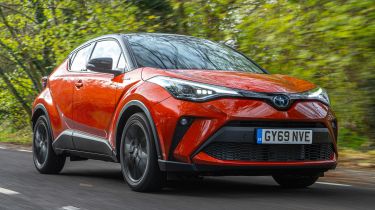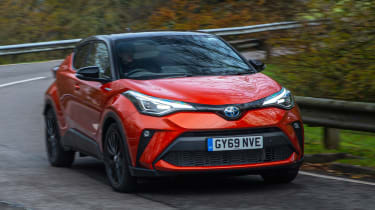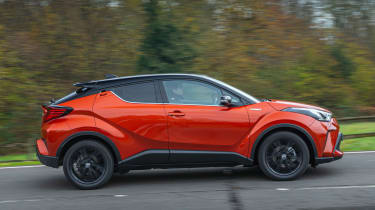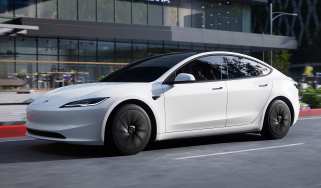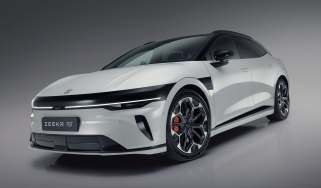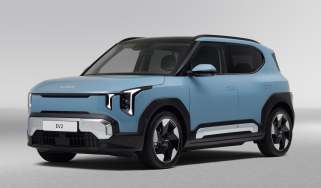Toyota C-HR (2016-2023) review - Engines, performance and drive
Sharp handling and a comfortable ride made the C-HR surprisingly good to drive

As Toyota has developed the C-HR with European and UK drivers in mind, its suspension has been tuned to cope with the unique demands of twisting and bumpy roads found both in Britain and on the Continent. In terms of the engineering, the C-HR's TNGA platform trumps most rivals. MacPherson strut front suspension is conventional enough, but it's paired with double wishbones at the rear, which is a more advanced set-up than the torsion beam rear axle used on most rivals, so it delivers better ride and handling than most, too.
When you get behind the wheel of the C-HR, it instantly feels sportier and more dynamic than rival machines. The steering is nicely weighted and although there’s not much connection to the front wheels, it’s easy to place the car where you want on the road. It helps that there’s less roll than in most crossovers, while the body movement you do feel is better controlled.
Toyota’s chassis feels firmer than some crossovers, but the damping is nicely judged, so it ties the body down well for faster cornering yet still manages to take the edges off bumps smoothly, delivering a composed and controlled, but comfortable, ride.
Front-wheel drive is standard across the range, while all versions get a choice of Sport, Normal and Eco modes, which alter the weight of the steering, the throttle response and CVT gearbox strategies to suit your mood and the road conditions. However, we found that the car felt most natural in Normal. The steering is well weighted and the high driving position gives a good view ahead, making it easy to place the car on the road and promoting confidence through corners.
Used - available now

2020 Volkswagen
Golf GTI
60,420 milesAutomaticPetrol2.0L
Cash £19,651
2020 Hyundai
i20
52,488 milesManualPetrol1.2L
Cash £7,999
2024 Honda
Civic
14,886 milesAutomaticPetrol2.0L
Cash £25,895
2013 Land Rover
Range Rover Evoque
76,754 milesAutomaticDiesel2.2L
Cash £8,983The hybrid’s CVT does require extremely delicate application of the throttle to stop the engine revs soaring. Mechanically this car is identical to the fourth-generation Prius, but it lacks that car’s impressive refinement and response. Even when accelerating reasonably gently, the gearbox sends the revs soaring – a problem that’s exaggerated by the petrol unit’s harsh note when extended.
In all other respects, the C-HR is a quiet and comfortable choice. Bigger bumps can be felt in the cabin, but most of the time the Toyota does a very good job of shrugging of poorly surfaced roads. And while there’s some wind rustle around the A-pillars, the rest of the interior is calm and composed on the motorway.
0-62mph acceleration and top speed
The C-HR is based on Toyota’s New Global Architecture chassis that also underpins the brand’s previous-generation Prius eco car and the current Corolla, as a result, the platform was designed with the acceptance of hybrid powertrains in mind. However, the more powerful 2.0-litre engine feels less strained than the 1.8-litre model, with Toyota re-engineering the steering and suspension to allow for the heavier 2.0-litre unit.
It’s likely that buyers who use the car as an urban runaround will appreciate the CVT auto and silent electric mode, but keen drivers will find the unit frustrating.
There’s certainly no denying Toyota has invested a lot of time and money in hybrid technology. Intensive development has led to the 1.8-litre unit delivering 40 percent thermal efficiency, which is higher than any other traditional petrol engine. The electric motors are also smaller yet deliver a stronger power to weight ratio, while the battery pack itself provides the same energy but is reduced in size by 10 percent.
The combined power output of the system is 120bhp, while torque is 142Nm from the internal combustion engine and 163Nm from the electric motor. Power for the 2.0-litre version is 181bhp, with torque at 190Nm via the ICE and 202Nm from its electric motor. Yet while these changes proved largely successful in the Prius, the new hybrid power unit isn’t quite as impressive in the C-HR.
Like all of Toyota’s petrol/electric models, a CVT (Continuously Variable Transmission) gearbox sends power to the wheels. This set-up theoretically delivers the ultimate in performance and efficiency, as it can constantly vary the gear ratio to keep the engine operating at its most efficient.
However, even gentle applications of the throttle send the engine revs soaring to a thrashy and coarse drone. Unlike the old Prius, the C-HR doesn’t seem as keen to use the electric motor to boost acceleration at low speeds.
The hybrid unit also doesn’t engage the battery power enough for silent electric running. There is an EV mode, which carries the car for around a mile in zero emissions mode, but left to its own devices only very, very gentle throttle applications will stop the petrol motor cutting in. Toyota has added a Sport setting to the hybrid, which sharpens the throttle response a little. However, it’s undermined by the transmission, which is slow to respond – and when it does drop a gear, the engine revs head skywards once again.
